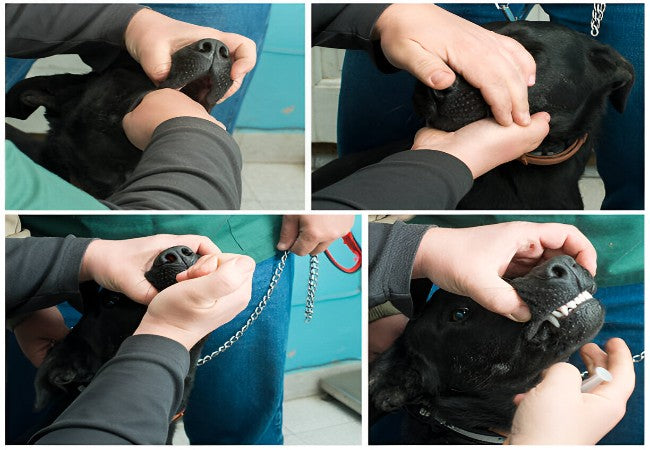Veterinary Guide to Canine Craniomandibular Osteopathy (CMO) 2025 🐶

In this article
Veterinary Guide to Canine Craniomandibular Osteopathy (CMO) 2025 🐶
By Dr. Duncan Houston BVSc
🧬 What Is Craniomandibular Osteopathy (CMO)?
Craniomandibular osteopathy (CMO), also called “lion jaw,” is a developmental, non-neoplastic condition in puppies where extra bone forms on the mandible, skull, temporomandibular joint (TMJ), and tympanic bullae. Affected dogs develop swelling and pain, especially when opening their mouth.
👥 Who's at Risk?
- Age: Typically 3–8 months, but can appear as early as 4 weeks.
- Breeds: West Highland White Terriers, Scottish Terriers, Cairn Terriers, Boston Terriers are highly predisposed; less frequent in Labradors, Great Danes, Bulldogs, Dobermans, Irish Setters.
- Genetics: Likely autosomal recessive, particularly in Westies.
- Other factors: Proposed links include canine distemper or bacterial triggers, especially in large breeds.
⚠️ Clinical Signs
- Painful mandibular swelling, often bilateral but may be asymmetric.
- Difficulty opening mouth (trismus), drooling, reluctance to eat, and weight loss.
- Intermittent fever and lethargy during active bone growth phases.
- Exophthalmos (bulging eyes) from bulla involvement.
🔍 Diagnostic Approach
- History & exam: Mandibular heat, swelling, pain on opening the mouth.
-
Imaging:
- Skull radiographs: Show periosteal bone proliferation on mandible and bullae.
- CT imaging: Offers detailed view of bone lesions; confirms extent.
- Bloodwork: May show elevated alkaline phosphatase and calcium/phosphate changes (likely due to growth).
- Bone biopsy: Rarely needed but can rule out osteomyelitis or neoplasia.
🛠️ Treatment Strategies
1. Pain Management (Core Component)
- NSAIDs: Carprofen, meloxicam—mainstay for reducing pain/swelling.
- Glucocorticoids: Prednisone may be used short-term if NSAIDs inadequate; avoid combined chronic use.
- Opioids: Tramadol added for moderate to severe pain.
2. Supportive Care & Nutrition
- Soft/gruel diets: Eases mastication—blend kibble with water, broth or canned food.
- Hand‑feeding or syringe feeding: May be needed for severe jaw pain; consider a feeding tube in critical cases.
- Fluids: IV or subcutaneous fluids, especially if fever, inappetence, or dehydration occur.
- Feeding assistance: Short, frequent meals, high-calorie content; supplements like omega-3 or collagen may support comfort.
3. Surgical Intervention (Rarely) & Special Cases
- Temporomandibular joint ankylosis: Surgery is considered if jaw immobility severely impairs feeding; outcomes are variable.
- Unresponsive severe cases: Euthanasia may be discussed if Quality of Life is poor and unmanageable.
📈 Prognosis & Monitoring
- Often self-limiting: bone proliferation typically regresses by 12–18 months of age.
- Puppies usually recover fully, though some jaw enlargement may persist.
- Prognosis is good with medical management, especially pain control and feeding support.
- Guarded if severe TMJ fusion leads to feeding incapacity requiring surgical or end-of-life considerations.
🏡 Home Care & Prevention
- Maintain a high-calorie, soft diet until comfort improves.
- Administer medications exactly as prescribed—track doses and taper when indicated.
- Monitor jaw warmth, appetite, fever, and energy daily.
- Avoid calcium supplementation unless vet-advised to prevent excess mineral-related growth.
- Avoid breeding affected dogs and close relatives due to a hereditary link.
📱 Ask A Vet Telehealth Support
- 📸 Share mouth/jaw photos to assess swelling and guide pain management.
- 🔔 Receive reminders for medication schedules and feeding times.
- 🩺 Video check‑ins help assess comfort, eating ability, and jaw mobility.
🎓 Case Spotlight: “Scout” the Westie Puppy
Scout, a 5‑month‑old West Highland White Terrier, developed painful jaw swelling and refused kibble after the onset of CMO. Veterinary radiographs confirmed typical periosteal bone proliferation. He received carprofen, tramadol, a gruel diet, and weekly telehealth check-ins via Ask A Vet. Over six months, swelling diminished and he returned to eating normal food. At 15 months, Scout is active, comfortable, and fully recovered—without surgical intervention.✨
🔚 Key Takeaways
- CMO is a self-limiting, developmental bone overgrowth in puppies, peaking at 3–8 months.
- Look for painful jaw swelling, difficulty opening mouth, drooling, reduced appetite, fever.
- Diagnosis via radiographs/CT; biopsy rarely needed.
- Pain management with NSAIDs, steroids, or opioids is essential.
- Support with soft diet, feeding assistance, and hydration is crucial.
- Most dogs fully recover by adulthood; surgical intervention is rare.
- Dogs affected or their siblings should not be bred.
- Ask A Vet telehealth offers photo triage, med reminders, nutritional guidance, and home delivery 📲🐾
Dr Duncan Houston BVSc, founder of Ask A Vet. Download the Ask A Vet app today to support your puppy through CMO—from remote comfort monitoring, pain relief coordination, to feeding strategies and specialist referrals 🐶📲






